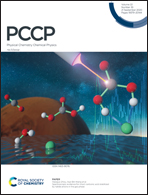Composition-dependent chemical and structural stabilities of mixed tin–lead inorganic halide perovskites
Abstract
Alloying tin into lead-based halide perovskites is one of the strategies to reduce the chemical toxicities associated with lead-containing compounds, while retaining comparable physical properties. However, tin-based compounds possess their own shortcomings, with the most critical ones being their increased thermodynamic tendencies towards oxidative degradation, as well as vibrational anharmonicities due to the presence of shallow Sn-5s2 lone-pair electrons. Hereby, we performed density-functional-theory calculations to systematically examine the composition-dependent chemical and structural stabilities for Cs(PbxSn1−x)X3 (X = Cl, Br and I) alloys. We found that oxidative degradation to rhombohedral Cs2SnX6, SnO2 and cubic CsSnX3 tends to be the most favored pathway with no observable composition-dependent ‘bowing behaviour’, the latter is primarily governed by the bowing-effects in the demixing energies which are generated when the perovskite alloy phase-segregates into the two cubic end-members, which are two orders of magnitude smaller. Potential surface energy scans for the off-center B-site ion displacements further reveal the nonlinearity in the change of vibrational anharmonicity with respect to a linear change of Sn concentrations. Such nonlinearity is strongly modulated by the nature of the halide ions, in order to minimize the exchange repulsion between the charge densities of Sn-5s2 lone pairs and the octahedrally coordinating halogen anions.



 Please wait while we load your content...
Please wait while we load your content...